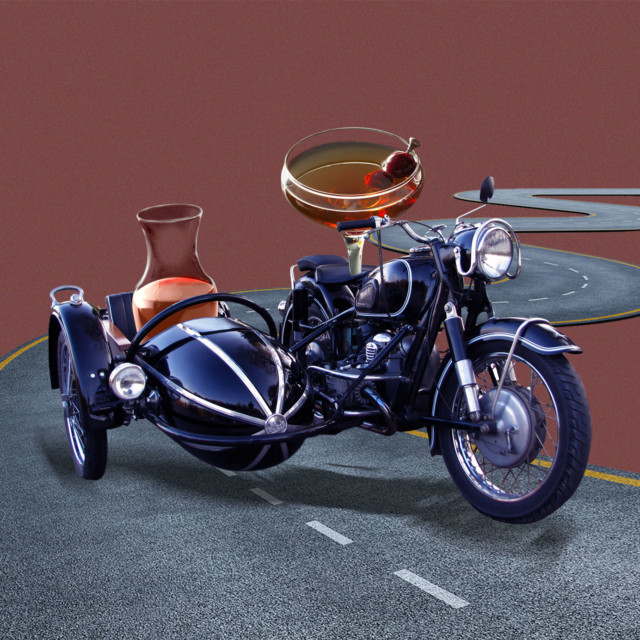After spending many months of the pandemic muddling — no pun intended — my way through various cocktail hours in my own kitchen, it’s hard to overstate the absolute thrill I get when ordering a drink at a bar. Absence certainly makes the heart grow fonder, but there’s also the allure of outsourcing the purchasing, measuring, and shaking up of ingredients, only to sip my order through a coupe or Martini glass that isn’t one of my own. And, if I’m especially lucky, there’ll be an accompanying side car for later.
For the uninitiated, the side car, (not to be confused with the lovely Sidecar cocktail) is the little carafe that sometimes appears over ice when you order a drink. It’s the sort of simple indulgence that channels the joy of having a neatly folded napkin waiting for you when you’ve returned from the bathroom, or enjoying a dollop of ketchup from a miniature ceramic side bowl. It undoubtedly makes for a cute Instagram post, but for classic drinks that are served up and best enjoyed ice cold, like a Martini or Manhattan, the side car’s primary purpose is to prolong the pleasure of a truly perfect sip by keeping half of your drink on ice. “It’s an elevated step of service — you have to have pellet ice, and it makes for more things to wash on the service end, but it really does make the drinking experience more pleasant,” notes Julie Reiner, founder of several bars including NYC’s Clover Club, one of the greatest contemporary champions of the side car. Reiner says that some patrons express confusion at the carafe’s purpose, and admits that more than one have sheepishly taken it as a shot. “If they’re willing to admit they don’t know what it’s for, we’ll explain that it’s to ensure the second half of your drink is just as good as the first. That’s when they typically acknowledge how brilliant of an invention it is.”
According to drinks historian David Wondrich, the side car traces its roots as far back as the 1950s, and remained popular well into the 1990s, with hotspots like the bar at the St. Louis Union Station Hotel using them for Martinis in 1997. Reiner, however, credits the now-shuttered Pegu Club and founder Audrey Saunders with the carafe’s modern resurgence across urban cocktail bars. “When I opened Clover Club, I took the side car from Audrey’s playbook,” she says. “It’s one of the best ideas in modern cocktail culture.”
As patrons eagerly sidle back up to bars across the country, the side car is enjoying its moment in the spotlight, having sadly proved irrelevant throughout a bleak summer of cocktail delivery and to-go drinks. At NYC’s Lodi, bar director Stacey Swenson reaches for it to serve up a particularly showstopping Black Manhattan. While the Rockefeller Center café clearly cares about aesthetic appeal — crisp white doilies underneath plates are commonplace, and serene flowers in neutral tones adorn the cozy space — Swenson is quite practical about the side car’s place at the table. “It adds value –– we can serve guests a slightly larger portion and the quality doesn’t suffer,” she explains. Meanwhile, at the iconic House of Prime Rib in San Francisco, Martinis arrive with an eye-catching retro crystal shaker side car; ask for a classic Aviation cocktail at Portland, Ore.’s Heathman Hotel, and you’ll enjoy the latter half out of a glass beaker.
The side car is also egalitarian. In the case of the Pornstar Martini, Birmingham-based Queen’s Park owner Laura Newman finds that the carafe can be a great vessel for holding a side of sparkling wine that a guest can, if they prefer, use to make their cocktail more acidic. With so many guests expecting a choice-happy approach to hospitality, the side car is poised to provide an extra dose of customization. Meanwhile, at Bushwick tortilleria Sobre Masa, beverage director Gaston Graffigna opts to use a side car for the Papazote, a Mexican riff on the classic Martini that uses mezcal, epazote, cardamaro, and chartreuse. “By serving the Papazote with the chilled side car and garnish choice, people can decide to enjoy their drink in whatever style they want, without sacrificing the integrity of the cocktail.”
“For me, the side car ultimately soothes drink anxiety,” Reiner says, laughing. “You don’t have to worry about your expensive cocktail declining into a drink that’s 10 degrees warmer, and also, it helps you pace yourself with these super-boozy drinks.” An indulgent night followed by limited hangxiety? Twist my arm.
